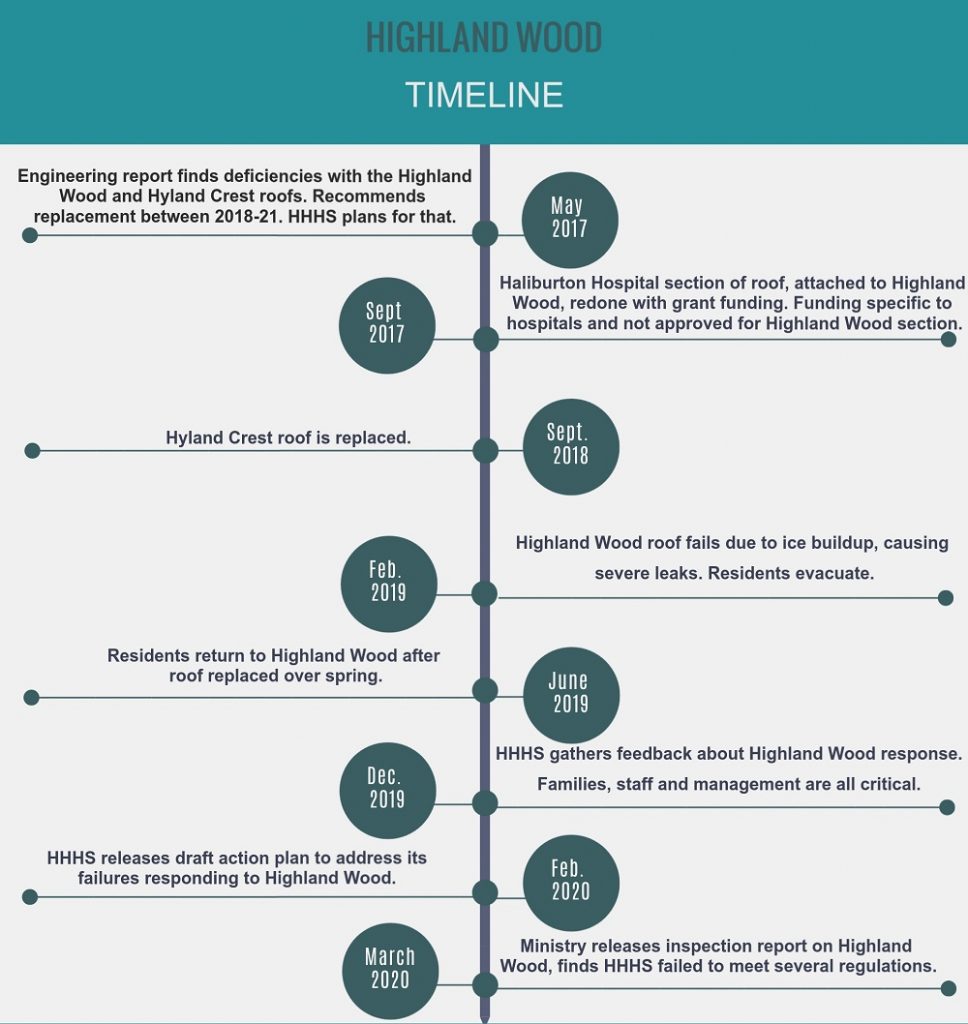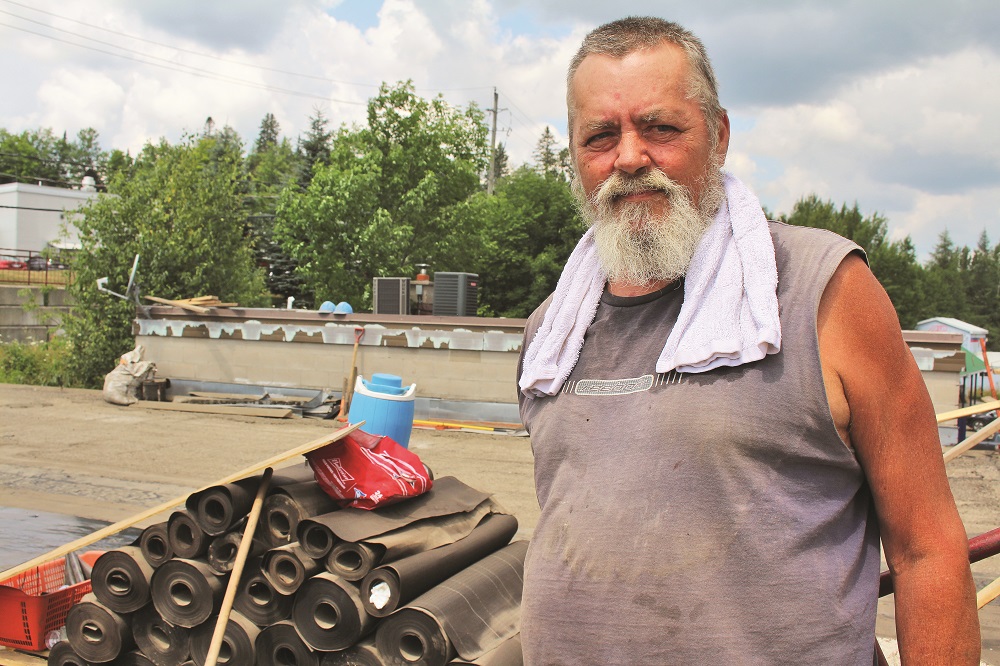Families of residents of Highland Wood in Haliburton are criticizing management of the long-term care home after an inspection found they failed to comply with maintenance regulations for the facility’s roof.
The Ontario Ministry of Long-Term Care completed an inspection Feb. 27, finding five regulatory infractions.
The issues relate to the roof severely leaking in February 2019, forcing the evacuation of residents. The report said Highland Wood was not complying with protocols for emergency planning, cleaning, and routine and preventative maintenance.
Family council chair Trina West said the report helps illustrate the families’ belief that the roof collapse was preventable, contrary to assertions of Haliburton Highlands Health Services (HHHS). She added HHHS should have repaired the roof in 2017, at the same time the attached hospital roof was fixed.
“The result of this negligence was the traumatic and unnecessary experience of the displacement of residents in the home due to the extensive roof leak in February 2019, causing severe distress to residents, families and staff,” West said in a June 17 letter from the family council to HHHS administration. “There must be accountability.”
HHHS president and CEO Carolyn Plummer said the organization had already identified some of the issues raised by the inspection and was addressing them through its action plan on Highland Wood released Feb. 21.
“The February inspection report will be helpful to identify strategies for continued improvement,” she said.
The February 2020 inspection was critical of several of Highland Wood’s policies. For one, it found HHHS “failed to ensure there were schedules and procedures in place for routine and preventative maintenance related to the roofing system and flooring material.” There were also no schedules for preventive inspection and there was no documentation of any spot checks, inspections and follow-up by maintenance staff in 2018.
“HHHS was conducting maintenance work and procedures regularly,” Plummer said in reply. “But is taking steps to improve documentation measures.”
The report also noted “three minor and short-lived ceiling leaks identified in June, July and October 2018.” The report said no contractor had inspected or made repairs to the roof in 2018, other than to provide quotes.
An inspection conducted by an engineering firm in May 2017 for the Haliburton hospital and Highland Wood roof identified several issues and suggested replacement between 2018 and 2021.
The report also found cleaning issues stemming from the roof leaks. A de-icing agent began leaking during the roof’s failure, causing white stains on carpets and baseboards. The stains are recurring but should diminish over time, the report said. However, the inspector found the HHHS manager of environmental services was not aware of persisting stains and had not developed a schedule to continually remove them. The report also found HHHS failed to ensure its emergency plans were reviewed and tested as much as regulated. The plans in place during the roof’s failure did not properly address communications and specific staff responsibilities. HHHS also failed in conducting a planned evacuation at least once in three years, as required.

Families press HHHS on preventability
HHHS has been under fire for the roof’s failure for more than a year. Residents were evacuated to other long-term care homes until an already-planned roof replacement for the spring could be finished. But there were difficulties, with some residents getting moved as far as Lindsay and Peterborough.
HHHS has relied on the word of a preliminary report from its insurer’s roof inspector, Michael Flynn of Michael Flynn and Associates Ltd., a Barrie-based forensic-engineering company specializing in disaster mitigation. Flynn said the “failure of the roof occurred suddenly without warning.”
“There were no ongoing signs of water infiltration or roof leaks, there are no signs of early failure,” Flynn wrote. “I want to assure you, this event occurred very early on within the service life of the roof and occurred without the normal signs of early failure. No one within your facility is at fault and certainly should not be blamed for this unfortunate incident.”
Flynn’s office declined a request for comment.
Plummer said the extreme weather fluctuations and freeze-thaw cycles created a gap in the roof flashing and a frost crack, allowing more water to leak. The weather created a problem beyond the surface of the roof HHHS had planned to address, she said. The incident also prompted HHHS to adjust the specs of its spring roof work to address the flashing. Plummer said they also retrofitted the flashing at Hyland Crest, a long-term care home in Minden, because of the incident.
Extreme weather damaging roofs was a documented issue in 2019. CBC News reported about a spike in insurance claims about roof damage that winter due to the weather.
In an email to HHHS, Flynn also said he would “attempt to determine the cause (of the failure) once I can substantiate the conditions in which the former and current roof were installed.” But Plummer said no further details or information about causes were ever provided to HHHS by its insurer or Flynn.
Families said they’d raised alarm about the roof not getting repaired in September 2017, the same time the Haliburton Hospital roof was replaced. HHHS received provincial grant funding to repair the hospital roof, but that did not extend to long-term care homes. However, HHHS made plans that year to replace roofs at both Hyland Crest and Highland Wood.
But West said splitting the hospital and Highland Wood roofs was nonsensical.
“It is the same building, so you cannot acknowledge the need to replace one side, then deny having knowledge of any problems with the roof and neglect to replace the other,” West said.
Plummer said it was unfortunate HHHS could not secure the funding for the Highland Wood roof to address it ahead of the planned timeframe. But she maintained the early failure of the roof occurred suddenly and without warning.
The ministry did not directly address a question posed by The Highlander about criticism regarding the lack of infrastructure funding for long-term care.
HHHS also conducted an internal investigation in the wake of the roof failure and found no “evidence of any earlier reports of problematic leaks or challenges,” according to HHHS vice president of support service and chief financial officer Kathy Newton in June 2019.
HHHS has acknowledged errors in its communication and emergency planning, through the release of a lessons learned and draft action plan Feb. 21. The report describes scathing feedback HHHS received from families in the wake of the roof failure. It also highlighted how there were members of staff and management who believed HHHS should have addressed the roof sooner and its failure was avoidable.
“It was preventable and it’s disgusting it was allowed to happen,” the general staff feedback section said. “Played Russian roulette and lost.”
“(Surprised) that the roof was not dealt with sooner,” the report said about general management feedback. “The previous
HHHS director of maintenance publicly said the roof was a ‘ticking time bomb.’ Surprised that there was no funding supplied.”
Plummer told The Highlander in February, after the report’s release, she had never heard those words from the previous director of maintenance and could not tell if it was accurate. The Highlander was unable to find any other record of the comment being made.
The action plan lays out actions HHHS would take in the short, mid and long-term to address the feedback, including improving emergency plans, a communication strategy and implementing an infrastructure renewal plan. But Plummer said increased workloads due to COVID-19 had delayed progress.
However, she added that the Highland Wood incident has informed efforts to improve communications about COVID-19 with staff, families, residents and the public. That has included regular messages, a hotline for staff and long-term care families, question and answer documents for staff and a community-based website with resources.
“We will continue to maintain and improve upon this more robust communication approach, and remain open to feedback,” Plummer said.
History of issues
Haliburton Roofing Ltd. owner Gunter Franke had done maintenance on the roofs of Highland Wood and Hyland Crest since they opened in 2000, up until HHHS discontinued use of his services in April 2018. Franke alleged his dismissal was over a dispute with a new maintenance director after he refused to do work in inclement weather. Plummer said Franke did refuse to work, but added it did not impact future consideration of him as a contractor.
Franke alleged the roofs had issues for years and should have been redone well before scheduled. Franke said he was regularly called to repair leaks at Highland Wood. As the years went by, Franke said he grew concerned about the state of the roof. He alleged he informed the former director of facilities and projects Peter Fearrey about the need to replace it, giving warnings since 2014/15.
“As the years got on, the worse the roof got, the harder it was to find the leaks,” Franke said. “Every time it got harder, I told … the maintenance guys it’s time. The roofs are shot.”

Mike Wilson owns Northland Coverings, another Haliburton roofing company. He said he was called to examine the roof for issues twice with Fearrey at least two years ago. After checking, he said he did not want to do any quotes on it.
“They just wanted patch work and it needed a full replacement like the hospital roof,” Wilson said. “All I can say is that it was years before the (Highland Wood) evacuation that they knew of the problems.”
He added he was called specifically to address leaks.
“They showed me where it was leaking on the inside,” Wilson said. “I just said the roof is past its life.”
HHHS picked Hyland Crest for roof work first in 2018 due to leak problems there, according to Newton. They planned to work on Highland Wood subsequently. As far as HHHS knew, there was no need to push the schedule up or have work at the two facilities done at the same time, Newton said.
“There wasn’t an active leak in Highland Wood. It wasn’t in failure. We were still a year ahead of the proactive plan,” she said. “There was nothing telling us, giving us any reason to be concerned.”
In response to the roofers’ accounts, Plummer again quoted from Flynn’s report about the roof and that the incident was unpredictable and occurred suddenly and without warning.
“HHHS does not believe there is reasonable basis to question the inspector’s conclusions,” she said.
Cindy Franke, Gunter’s partner, said the situation reflects poorly on them as they maintained the roof for years. She further said she disagrees with how HHHS has portrayed the situation.
“They’re making it sound like this was all of a sudden,” she said. “That’s not how it happens.”
West said ultimately, the Highland Wood roof evacuation caused a great deal of hardship and damage for the people involved.
“The mental damage, psychological damage is the biggie here in this. The psychological damage done to the residents and the families,” she said. “Nothing like this should ever happen to vulnerable people like this.”
COVID-19 puts long-term care homes under scrutiny
The province is placing long-term care homes under scrutiny after COVID-19 outbreaks, deaths, and military reports of neglect at several privately-run homes. They are launching an independent commission to identify systematic issues.
There have been no such reports for HHHS homes and no COVID-19 cases in them. Plummer said HHHS welcomes the commission.
“As has been seen through the COVID-19 pandemic, there is a need for more investments in the Long-Term Care sector in terms of infrastructure, staffing, equipment and training,” Plummer said. “HHHS hopes to see these issues raised through the course of the independent commission’s work.”
Plummer said the pandemic has resulted in hospitals assisting long-term care homes across the province. It is a model HHHS has used for years, with its integrated buildings and programs. Plummer said it would be good if the province could provide funding in a way that reflected that integration.
“It would be of great value for integrated organizations such as ourselves if we were able to operate from a seamless or single funding pool so that resources could be unified across all programs and facilities,” Plummer said. “We will actively seek opportunities to share our experiences and provide input to support positive change for the Long-Term Care sector.”
Ministry of Long-Term Care spokesperson Tanya Blazina said the forthcoming commission will address issues and uncover how COVID-19 impacted long-term care.
“This independent, transparent commission will get to the bottom of this crisis and enable us to take quick and decisive action to address the pressing issues facing our long-term care homes. Ontarians deserve answers, and they will get them,” she said. “Details including terms of reference, membership, leadership of the commission and reporting timelines, will be announced in the coming weeks.” (Joseph Quigley)





